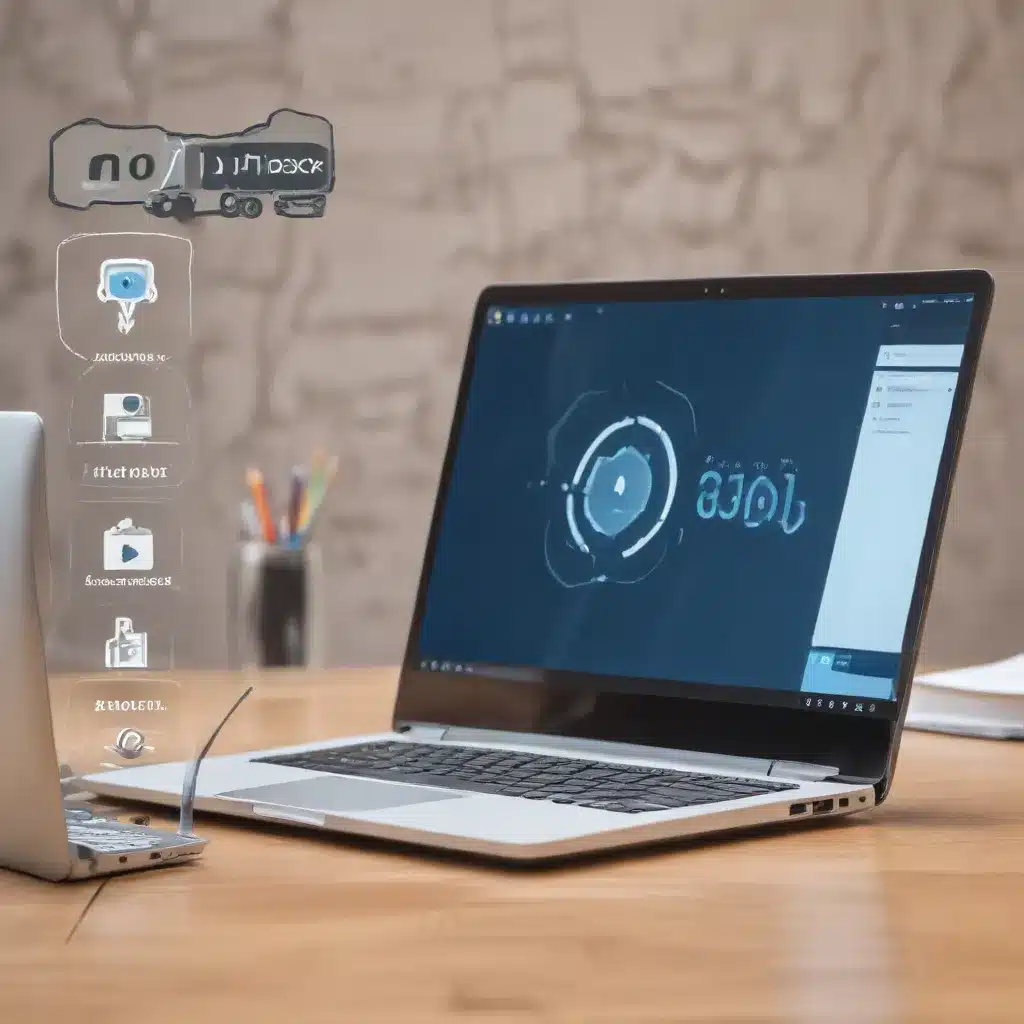Optimizing Computer Performance: A Comprehensive Guide
As an experienced IT specialist, I’ve had the privilege of working with a wide range of clients, each with unique technological needs and challenges. Over the years, I’ve developed a deep understanding of the intricacies involved in maintaining and optimizing computer systems, and I’m excited to share my insights with you.
One of the most common issues I encounter is sluggish computer performance. Whether it’s a slow boot-up time, lagging applications, or frequent system freezes, these problems can be incredibly frustrating for users. But fear not, there are several proven techniques to help you breathe new life into your devices.
Let’s start with the basics: regular system maintenance. Ensuring that your operating system, drivers, and software are up-to-date is crucial for optimal performance. Outdated components can cause compatibility issues, security vulnerabilities, and overall system instability. Make it a habit to check for and install the latest updates, as they often include important bug fixes and performance enhancements.
Next, consider the state of your computer’s storage. Over time, the hard drive or solid-state drive can become fragmented, leading to slower file access and system responsiveness. Regularly running a disk defragmentation tool can help reorganize your data and improve read/write speeds. For an even greater boost, consider upgrading to a faster solid-state drive, which can significantly reduce boot times and application loading.
RAM (Random Access Memory) is another key component that can impact your computer’s performance. If you’re running multiple applications or working with large files, having adequate RAM can make a noticeable difference. Upgrade your RAM if your system is struggling to keep up with your demands, and be sure to check the manufacturer’s recommendations for compatible modules.
Speaking of hardware, keeping your computer’s cooling system in good condition is also essential. Overheating can cause systems to throttle their performance or even shut down unexpectedly. Regularly cleaning the fans and heatsinks, and ensuring adequate airflow, can help maintain optimal operating temperatures and prevent thermal-related issues.
Safeguarding Your Data: Effective Cybersecurity Measures
In today’s digital landscape, cybersecurity is of paramount importance. As an IT specialist, I’ve witnessed firsthand the devastating impact that cyber threats can have on individuals and businesses alike. From ransomware attacks to data breaches, the risks are ever-present, and it’s crucial that we take proactive steps to protect ourselves and our clients.
One of the fundamental pillars of cybersecurity is strong password management. Encourage your users to create unique, complex passwords for each of their accounts, and consider implementing a password manager to securely store and generate these credentials. Two-factor authentication should also be enabled wherever possible, adding an extra layer of protection against unauthorized access.
Keeping your software up-to-date is another essential cybersecurity measure. Software vendors regularly release patches and updates to address known vulnerabilities, and it’s crucial that you apply these updates in a timely manner. Neglecting to do so leaves your systems exposed to potential exploits and malware infections.
Implementing robust backup strategies is also a must. Regularly backing up your data, both locally and to the cloud, can be a lifesaver in the event of a ransomware attack or hardware failure. Consider using a combination of techniques, such as incremental backups and versioning, to ensure that you can quickly restore your data and minimize downtime.
Firewalls are another critical component of a comprehensive cybersecurity plan. These network security devices act as gatekeepers, monitoring and controlling the flow of traffic in and out of your systems. Ensure that your firewalls are properly configured and kept up-to-date to effectively mitigate external threats.
In addition to these foundational measures, it’s important to educate your users on cybersecurity best practices. Phishing attacks, social engineering, and other social-based threats can be the weakest link in your security posture. Provide regular training on identifying and reporting suspicious activity, and encourage a culture of security awareness within your organization.
Embracing Technological Advancements: Harnessing the Power of Innovation
In the ever-evolving world of IT, embracing technological advancements is crucial for staying ahead of the curve. As an experienced specialist, I’ve witnessed the rapid pace of innovation and the transformative impact it can have on the way we work, communicate, and interact with technology.
One area that has seen significant advancements in recent years is cloud computing. The rise of cloud-based services has revolutionized the way we store, access, and collaborate on data. By leveraging the cloud, users can enjoy seamless synchronization across devices, increased data security, and the flexibility to work from anywhere. As an IT professional, I’ve seen firsthand how the cloud can streamline workflows, improve productivity, and reduce the burden of local infrastructure management.
Artificial intelligence (AI) and machine learning (ML) are also poised to have a profound impact on the IT industry. These technologies are already being used to automate repetitive tasks, enhance system monitoring and diagnostics, and even assist in cybersecurity threat detection. By harnessing the power of AI and ML, IT professionals can optimize resource utilization, identify potential issues before they arise, and provide more personalized support to their users.
The Internet of Things (IoT) is another technological advancement that is transforming the way we interact with our environment. From smart home devices to industrial automation, IoT has the potential to revolutionize how we monitor, control, and optimize systems. As an IT specialist, I’ve explored the integration of IoT technologies into various client applications, enabling remote monitoring, predictive maintenance, and data-driven decision-making.
While these advancements present exciting opportunities, they also come with their own unique challenges and considerations. Ensuring data privacy and security, managing complex integrations, and keeping up with the rapid pace of change are just a few of the hurdles that IT professionals must navigate. However, by embracing a growth mindset and continuously learning, we can adapt and thrive in this dynamic technological landscape.
Empowering Users: Bridging the Gap Between Technology and Individuals
As an IT specialist, I firmly believe that our role extends far beyond simply maintaining and troubleshooting technology. We have a unique opportunity to empower users and bridge the gap between complex systems and individual needs.
One of the most common pain points I encounter is user resistance to new technologies or processes. Change can be daunting, and it’s our responsibility to guide users through the transition with patience and empathy. By taking the time to understand their concerns, providing clear and accessible training, and fostering a collaborative environment, we can help users overcome their apprehensions and unlock the full potential of the tools at their disposal.
Equally important is the need to tailor our support to individual user needs. Not everyone learns or interacts with technology in the same way, and it’s essential that we adapt our communication styles and troubleshooting approaches accordingly. Whether it’s providing step-by-step walkthroughs, offering visual aids, or simply taking the time to listen and understand the user’s perspective, these personalized touches can make all the difference in delivering a positive support experience.
Another key aspect of empowering users is encouraging self-sufficiency and problem-solving skills. While we may be the go-to experts for technical issues, it’s important to equip users with the knowledge and resources they need to tackle common challenges on their own. By fostering a culture of digital literacy and self-help, we can empower users to become more independent, confident, and resilient in their technology-driven tasks.
Ultimately, our role as IT specialists is not just about maintaining the hardware and software – it’s about empowering the people who rely on these tools to achieve their goals. By prioritizing user needs, promoting digital literacy, and fostering a collaborative, supportive environment, we can help individuals unlock their full potential and unlock the true power of technology.
Conclusion: Embracing the Future of IT
As we look to the future, the IT landscape is poised to undergo even more rapid and transformative changes. From the continued advancements in cloud computing and artificial intelligence to the emerging possibilities of quantum computing and biotechnology, the opportunities for innovation and disruption are vast.
As an experienced IT specialist, I’m excited to be at the forefront of these technological shifts, constantly learning, adapting, and finding new ways to leverage these advancements to benefit my clients and the wider IT community. Whether it’s optimizing system performance, safeguarding critical data, or embracing cutting-edge technologies, my commitment to excellence and continuous improvement remains unwavering.
But the future of IT is not just about the technologies themselves – it’s about the people who use them. By empowering users, fostering digital literacy, and cultivating a collaborative, supportive environment, we can unlock the true potential of technology and positively impact the way individuals and organizations work, communicate, and thrive.
So, as we continue our journey through the ever-evolving world of IT, let’s embrace the challenges and opportunities that lie ahead. By staying curious, keeping our skills sharp, and prioritizing the needs of our users, we can become the trusted guides and innovators who shape the future of technology. Together, we’ll unlock new levels of efficiency, security, and innovation, and cement our place as indispensable partners in the digital age.
Visit itfix.org.uk to explore more of our expertise and insights in the world of IT.













